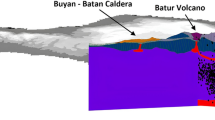Abstract
Volcanic basalt eruption activity in the South China Sea and adjacent areas occurred strongly in Cenozoic E ra. However, it is difficult to define their ranges and spatial locations.
This paper presents the methods of reduction to the magnetic equator in low latitudes to bring out a better correlation between magnetic anomalies and their causing-sources; high-frequency filtering is to separate gravity and magnetic anomalies as well as information about the volcanic basalts in the upper part of the Earth’s crust; 3D total gradient is to define the spatial location of high density and magnetic bodies. The distribution of eruptive volcanic basalt is determined by multi-dimensional correlation analysis between high frequency gravity and magnetic anomalies with weighted total gradient 3D.
The results from the above-mentioned methods have shown that the distribution of the eruptive volcanic basalt is mainly concentrated along the South China Sea’s sea floor-spreading axis, transitional crust, Manila trench and some large faults zone. These results are improved by existing boreholes and seismic data in the study area.
Similar content being viewed by others
References
M. F. J. Flower, M. Zhang, C.-Y. Chen, K. Tu, and G. Xie, “Magmatism in the South China Basin. 2. Post-Spreading Quaternary basalts from Hainan Island, south China,” Chem. Geol. 97, 65–87.
http://geomag.org/models/emag2.html.
http://geosoft.com/media/uploads/resources/technical-papers/
www.ngdc.noaa.gov/geomag-web/#declination
I. K. Karoly, “Transfer properties of the reduction of magnetic anomalies to the pole and to the equator,” Geophysics 55 (9), 1141–1147 (1990).
Le Huy Minh, Luu Viet Hung, and Vo Thanh Son, Reduction of Magnetic Anomalies to the Pole for the Map of Vietnam Magnetic Anomalies (Institute of Geophysics, 2003).
T.-Y. Lee, C.-H. Lo, S.-L. Chung, C.-Y. Chen, P.-L. Wang, W.-P. Lin, N. Hoang, T. C. Cung, and T. Y. Nguyen, “40Ar/39Ar dating result of Neogene basalts in Vietnam and its tectonic implication,” in Mantle Dynamics and Plate Interactions in East Asia, Ed. by M. F. J. Flower et al., Geodynamics Ser. 27, 317–330 (1998).
S.-L. Li, X.-H. Meng, L.-H. Guo, C.-L. Yao, Z.-X. Chen, H.-Q. Li, “Gravity and magnetic anomalies field characteristics in the South China Sea and its application for interpretation of igneous rocks,” Appl. Geophys 7 (4), 295–305 (2011).
M. W. McElhinny, Palaeomagnetism and Plate Tectonics (Cambridge, London, 1973).
Nguyen Hoang and Phan Trong Trinh, “Characteristics of lithological and geochemical characteristics of Neogene–Quaternary volcanic rocks and mantle dynamics in the East Sea of Vietnam and adjacent,” J. Geol. 312 (2009).
Phùng Văn and Bùi Công Quế, “Môt số lu â n giái tù’ các tài liệu đia vật lý vê cấu trúc và lịch sù’ phàt triện v ậ o đại duong trên Biên Ðôong,” Tap chí KHCN bien, No. 3 (2001).
D. T. Sandwell, E. Garcia, K. Soofi, P. Wessel, and W. H. F. Smith, “Towards 1 mGal global marine gravity from CryoSat-2, Envisat, and Jason-1,” The Leading Edge 32 (8), 892–899 (2013). doi: 10.1190/tle32080892.1.
“Total magnetic field reduction the pole or equator? A model study,” Can. J. Explor. Geophys. 24 (2), 185–192 (1988).
Tran Tuan Dung, Bui Cong Que, and Nguyen Hong Phuong, “Cenozoic basement structure of the South China Sea and adjacent areas by modeling and interpreting gravity data,” Russ. J. Pac. Geol. 4, 227–236 (2013).
Tran Tuan Dung, “Characteristics of structure–tectonic in the deep water of the East Sea of Vietnam based on interpretation of gravity and magnetic anomaly data,” in The 35th Conference of Vietnam Petroleum Institute, (Ho Chi Minh, 2013), pp. 55–56
Tran Tuan Dung, Nguyen Quang Minh, and Vu Thu Anh, “Influence of bathymetry on gravity anomalies in the East Sea of Vietnam and adjacent,” Oral at the International Conference of the East Sea of Vietnam: 90 Years of Oceanography Operational in the East Sea of Vietnam and Adjacent (Nha Trang, 2012).
Author information
Authors and Affiliations
Corresponding author
Additional information
The article was translated by the authors.
Recommended for publishing by R.G. Kulinich
Rights and permissions
About this article
Cite this article
Dung, T.T., Que, B.C. & Minh, N.Q. Distribution of eruptive volcanic basalt in the South China Sea and adjacent areas by interpreting gravity, magnetic and seismic data. Russ. J. of Pac. Geol. 10, 1–12 (2016). https://doi.org/10.1134/S1819714016010024
Received:
Published:
Issue Date:
DOI: https://doi.org/10.1134/S1819714016010024




